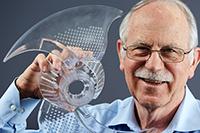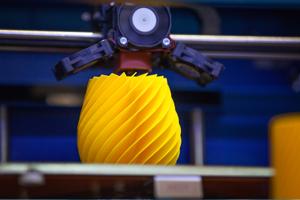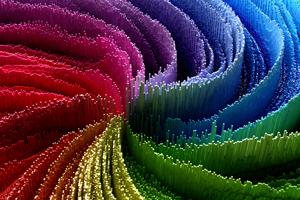About additive manufacturing (AM)
Last updated: 22.1.2020

Many objects, from household items to motor parts, are produced in one of two ways. Either they are formed from a single mass of material for example a piece of clay is formed into a plate. Or they are milled or carved from a larger block of material, as when grooves are cut into a rod of steel to make a bolt.
An alternative approach is to deposit a thin layer of material, perhaps as a powder or gel, and then add another layer on top, followed by another and another, and so on. This process of adding and adding gave rise to the name additive manufacturing (AM), more commonly known as 3D printing. A further step to harden all or part of each layer is required between depositions. By changing the dimensions of each layer, objects of fantastic complexity can be created in ways that no other manufacturing process has ever achieved.
AM could revolutionise the way we live, enabling many of the most basic everyday products, from hair combs to kitchen utensils, to be printed and even repaired at home on a 3D printer.
Meet Charles W. Hull

Charles "Chuck" Hull worked with ultraviolet light with the aim of hardening surface coatings. In 1983 he came up with the idea of using epoxy resin, already used just for coatings, in thin laminated layers, one on top of the other, and etching their shape with ultraviolet light: the electrolytic 3D printer was born. Today, every 3D printer works on the basis of his idea. In 2014 he won the European Inventor Award in the category "Non-European countries" for this work.
Sustainability
Additive manufacturing will disrupt established practices and overturn conventional assumptions about mass production in distant factories. Local fabrication in small volumes, or even of single items, close to the end user will become viable.
The benefits to the environment are clear – the transportation and packaging of finished articles will be reduced, as will the storage of items awaiting buyers. Most importantly, 3D printing enables production to take place on demand at the place and time required, with a minimum of waste and pollution. 3D printing will also help promote a “repair culture”, making it easier for consumers to print spare parts for household goods and appliances, instead of throwing these away.

IP and AM
Additive manufacturing provides a fascinating example of how different intellectual property (IP) rights can overlap. A 3D-printed object such as a figurine or vase is principally aesthetic and therefore protected by copyright; the same object, or its surface decoration, could be registered for design protection too. Other products such as tools or components with functional features could be eligible for patent protection of novel and inventive technical aspects. But patents can also protect both the machines that do the additive manufacturing and the processes that these printers carry out. In addition, the printers execute instructions from digital files that are also protected by copyright.

In future, the production of a vast array of decorative and functional articles will be in the hands of the broader public. This democratisation of production will not only disrupt supply and distribution patterns, but impact many intellectual property rights too. Designers of new products will be able to licence their designs directly to the consumer, who can then print the object locally. Just as new digital platforms for streaming video and music have led to a boom in creativity and new commercial opportunities, so the sharing of 3D design files for printing anywhere in the world will create new business models. At the same time, legislators must ensure that IP regimes adapt to ensure fair protection and remuneration for designers.
- How the EPO is responding
-
Patent applications to the European Patent Office (EPO) for AM technologies have seen dramatic growth, involving a wide variety of innovations in machines, materials and processes. Over the last 20 years, the volume of such patent applications filed at the EPO has steadily increased, substantially so since 2013.
The diffusion of AM technologies across many industry sectors, thanks in particular to their flexibility and competitive cost among many other advantages, has also impacted numerous technical fields, including healthcare, automotive, aerospace, housing, industrial tools, footwear and food processing. The EPO has foreseen and dealt with associated challenges in ways that help both researchers and inventors keep track of developments.
Examiners at the EPO and United States Patent and Trademark Office have updated their comprehensive patent classification scheme to provide indexing marks for new AM technologies. By classifying relevant AM patent applications within the scheme under e.g. B22F3, B29C64 and/or B33Y, examiners can decide what is really new and therefore deserving of a patent. All EPO examiners follow comprehensive guidelines which reflect the latest case law, ensuring that they adopt a harmonised approach to AM patentability during both grant and opposition processes.
The interdisciplinary nature of this technology also requires greater cooperation between examiners. Examining and opposition divisions are composed of three qualified members, enabling a holistic approach to each and every application.
- AM and product-by-process claims
-
A recurrent issue in patent applications concerning additive manufacturing is the patentability of product-by-process claims. Here, the practice of EPO examiners is well defined in the EPC Guidelines, F-IV, 4.12. A product obtained by an AM process can be patented only if
- the product as such is new and inventive, and
- it is not possible to define the claimed product other than in terms of the process of manufacture.
A product is not necessarily new and inventive merely because it is obtained by a new process. It is therefore crucial to establish whether the product-by-process is different from existing products obtained by other technologies. If yes, the inventive step merit of the new product still has to be considered.
- Claims directed to computer implemented inventions (CII)
-
Given that the additive manufacturing process is wholly based on a digital file, AM innovation often involves computer implemented inventions. The relevant EPO practice is described in dedicated sections of the EPC Guidelines (see for example F-IV, 3.9 on the formulation of claims directed to computer programs; for more general information, see also the Index for Computer-Implemented Inventions). Where these claims concern the implementation of specific additive manufacturing methods, specific technical devices must usually feature as essential elements of the definition of the invention (see in particular F-IV, 3.9.2). This also fulfils the requirements of clarity set out in Article 84 EPC.
AM and standards
AM is driving a paradigm shift in manufacturing, altering the boundaries between manufacturers and end-customers. A product can now be manufactured anywhere and at any time. For example, a bone implant originally designed by a company in the US might be produced years later by a team of surgeons during a medical procedure in Germany, Taiwan or South Africa, using additive manufacturing devices and different materials from those originally envisaged.
This requires the establishment of reliable international industry standards to ensure the seamless cross-platform communication of data formats, design programs and devices, as well as the quality assurance of raw materials and final products.
As of 2020, eight ISO/ASTM standards (active or under development) have also been approved as European Standards (EN).
- ISO/ASTM 52900:2015 Additive manufacturing - General principles - Terminology
- ISO/ASTM 52901:2017 Additive manufacturing - General principles - Requirements for purchased AM parts
- ISO/ASTM 52902:2019 Additive manufacturing - Test artifacts - Geometric capability assessment of additive manufacturing systems
- ISO/ASTM 52910:2018 Additive manufacturing - Design - Requirements, guidelines and recommendations
- ISO/ASTM 52915:2016 Specification for additive manufacturing file format (AMF) Version 1.2
- ISO/ASTM 52921:2013 Standard terminology for additive manufacturing - Coordinate systems and test methodologies
- ISO/ASTM 52904:2019 Additive manufacturing - Process characteristics and performance - Practice for metal powder bed fusion process to meet critical applications
- ISO/ASTM 52911-1:2019 Additive manufacturing - Design - Part 1: Laser-based powder bed fusion of metals